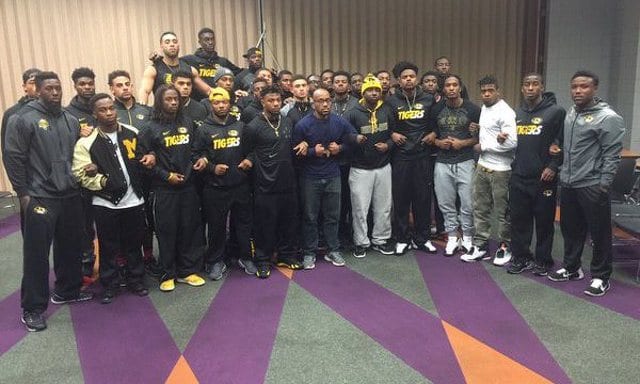The University of Missouri is a very Penn State-like place.
It has 35,000 students and is smack-dab in the middle of the state, roughly equidistant from major urban areas to the east (St. Louis) and west (Kansas City).
Like ours, Mizzou’s football team is named for a big cat (the Tigers) and plays in a major conference (the Southeast) before big crowds (71,000).
Could the protests of institutional racism that turned the Missouri campus upside down last week happen at Penn State? That’s like asking, as a New York Times opinion piece did this week, if the Paris attacks could happen in the U.S.
Uh, they already have. (Weirdly, the big anti-racism protest at Penn State, like the big terrorist attack on the United States, happened in 2001.)
Protests by “marginalized students,” as they call themselves, can also happen at a place like Claremont-McKenna College. CMC has 1,200 students and is a 40-minute drive east from Los Angeles. Its Division III football team is made up of students from CMC and its two sister schools, Harvey Mudd and Scripps, and it plays its home games before 3,000 people.
If the Stags decided not to play a game in solidarity with their fellow students, as the Mizzou Tigers threatened to do last week, it’s possible no one would notice. It’s doubtful the threat would lead to the resignation of top administrators.
But CMC’s president and its dean of students were on the hottest of hot seats a few days ago and as is inevitably the case in the surveillance society, their discomfiture is on display for all to see.
The simmering anger of minority students boiled over when a Latina student made public a letter from Dean Mary Spellman in which Spellman assured the student that her office was “working on how we can better serve students, especially those who don’t fit our CMC mold.”
It was, needless to say, a horrible choice of words, as Spellman acknowledged in a written apology to the student body. She then appeared at a rally to apologize in person. Students implored her to refrain from political doubletalk and “speak from the heart.”
She tried. The term “CMC mold,” she said, didn’t come from her own attitudes about who does and does not belong at Claremont-McKenna, but from struggling minority students themselves who fear that they do not fit in.
This sounded plausible to me, a white, middle-aged professor watching the action unfold on my laptop, 2,500 miles away. It didn’t sound plausible to the frustrated minority students at Claremont-McKenna. They wanted her gone.
Next, it was President Hiram Chodosh’s turn. Chodosh, the students said, had promised to act on their demands for a resource center, among other things, but had not followed through. Now he stood before them, silent, hands clasped in front of him like he was facing a firing squad.
Eventually, he caved on the demand for a resource center, but his inquisitors wanted more. They wanted him to ditch Dean Spellman.
Spellman tried again to clarify what she meant by fitting the CMC mold and to affirm her commitment to fighting for students, but it was too late.
Whether the “mold” e-mail was part of a larger pattern of insensitivity, as some students claimed, is impossible for an outsider to know. What’s clear from the hour-long recording of the rally is that a lot of students no longer trusted her, which made it hard to see how she could effectively do her job.
She resigned the next day.
I’m torn about the recent uproars at Claremont-McKenna, at Missouri, at Yale, and elsewhere. To all who have mocked student protesters as coddled hot-house flowers with their demands for “safe spaces” from “micro-aggressions,” I offer these wise words from the English critic and artist John Berger:
“One protests because not to protest would be too humiliating, too diminishing, too deadly…To protest is to refuse being reduced to a zero and to an enforced silence. Therefore, at the very moment a protest is made, if it is made there is a small victory.”
At the same time, I couldn’t help feeling sorry for Spellman and Chodosh. Who among us has not spoken clumsily? Who does not have a blind spot about this or some tone-deafness about that?
While we should not lose sight of the fact that the students are the aggrieved party here, I gotta say, the show-trial vibe of their rally creeped me out. Alongside the entrenched pattern of racism, sexism, and homophobia the students are fighting against, there is this new pattern of merciless denunciation and summary rejection of any whose words or deeds can be construed as micro-aggressive.
With the paroxysms of violence that have convulsed the world in the past week, we might wish to turn down the heat a little at home, to work to change institutions, but to forgive each other our moments of cluelessness.



